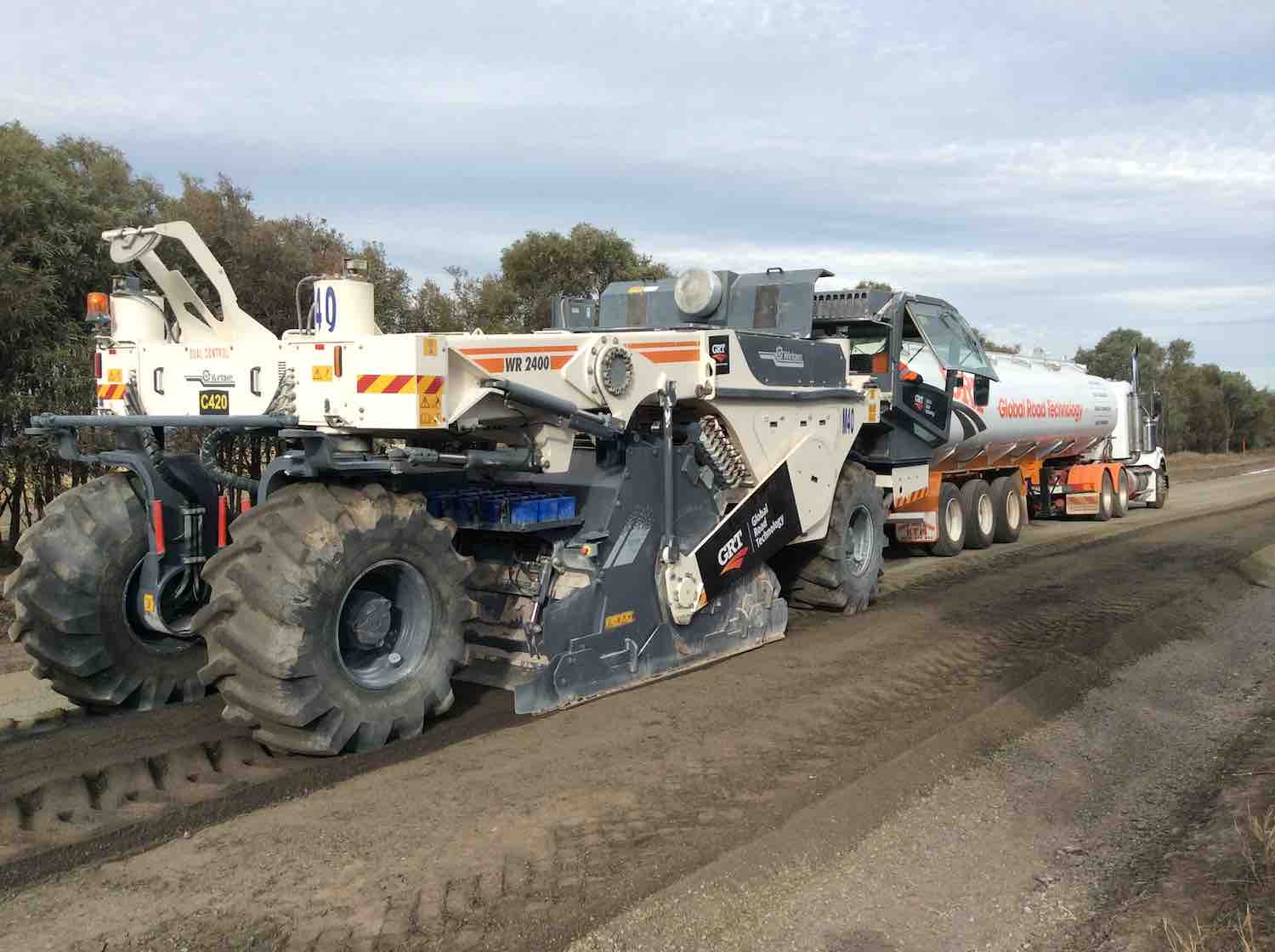
Foamed bitumen is essentially a mixture of air, water and bitumen. When a small quantity of cold water is injected into hot bitumen (180°C), the bitumen expands by approximately 15 times its original volume with low viscosity. The large surface areas and low viscosity of foamed bitumen facilitate the greater dispersion of bitumen in the aggregate skeleton. The drive for more sustainable production processes and construction materials has made foamed bitumen an interesting solution for asphalt pavements for warm mix and recycled asphalt mixtures. Foamed bitumen used in Australia is Class 170 bitumen which is temporarily brought into a foamed state by the addition of water and chemical additives such as foaming agents which improve the foaming characteristics of bitumen. Foamed bitumen is one of the most interesting applications of bitumen due to the low quantity of water and additives used.
In this article, Global Road Technology evaluates foamed bitumen from an Australian perspective.
Foamed bitumen was originally developed in 1950s by Csanyi. After 1968, Mobil Oil Australia Ltd, developed methods to improve the production of foamed bitumen as well as mix design procedures. Continental Oil Company had further developed the process and had been licensed by Mobil Oil of Australia Ltd, to market the process in the United States of America. From the mid-1970s to the mid-1980s, the bitumen foaming process has been successfully tired and tested in Australia and the United States. Since the expiration of Mobil’s patent on the foamed bitumen process and subsequent intensive research, many road authorities worldwide have carried out successful trials using foamed bitumen stabilisation technology. The CSIR in South Africa developed a standard design procedure based on the in-situ method of construction to specify asphalt mix design.
Foamed bitumen is formed when bitumen interacts with steam, creating a low viscosity foam, which results in a change in the interfacial tension and substantial increase in the bitumen surface area. The process has now evolved, and foamed bitumen can be obtained either using water bearing additives or by direct injection of water into hot bitumen. Foamed bitumen is normally chosen as a solution to produce cold asphalt mixtures or in-situ stabilisation or recycling of asphalt pavements with some variable materials such as gravel with some plasticity. Compared to bitumen emulsions, foamed bitumen demands a shorter curing time. The kitchen analogy of foamed bitumen is as follows:
“Foamed bitumen is analogous to a baker beating an egg, which is viscous into foam of low viscosity before mixing it with flour. The beaten egg increase in volume, which is necessary to evenly distribute it among the flour and produce a mix of acceptable quality and consistency.”
Similarly, the foamed bitumen increases in volume, facilitating a good bitumen distribution over the aggregates.
Although foamed bitumen technology has evolved, the quality of foamed bitumen depends on a significant number of parameters and these parameters include:
Curing is the process by which foamed bitumen mixtures (FBMs) gain strength or stiffness with expansion of water. There is a lot of complexity that water brings to FBMs because water plays different roles during different stages of the mix design. Factors affecting curing of FBMs include:
In the production of hot mix asphalt, the relevant characteristics used are penetration, softening point and viscosity but for foamed bitumen these characteristics are not enough. The maximum expansion ratio and the half-life are used to characterise the type of binder. The expansion ratio is the ratio between the bitumen volume after the foaming process and its initial volume, and the maximum expansion ratio is obtained immediately after spraying into a vessel of known capacity. The value is a measure of foamed bitumen viscosity and is related to wettability of the foamed bitumen and the workability of the resulting mixture. The half-life is the time elapsing between the moments when the foamed bitumen reaches its maximum volume and half of that value. The value is a measure of a foamed bitumen’s stability, and it is proportional to the time available for mixture production.
To obtain the best foamed bitumen quality for mixture production it is necessary to optimise these values, by selecting the parameters, mainly water content which result in sufficiently high maximum expansion ratio and sufficiently long half-life. A combined index which considers both expansion ratio and half-life is known as the foam index, and this goes to describe the foamed bitumen behaviour after production which is depicted in the decay curve which often undergoes an asymptotic expansion reduction with time. The foam index is the area under that curve, and above a minimum expansion ratio of 4. The shape of the decay curves and corresponding equations can also give valuable information to be used in the characterisation of foamed bitumens.
The utilisation of high temperatures to the production and application of new asphalt mixtures also causes high levels of greenhouse gas emissions. Foamed bitumen offers a way to reduce production temperatures of half-warm mix, warm mix asphalts, in-situ, and plant-mixed stabilisation. Incentive of foamed bitumen is that it can be used as a stabilising and recycling agent with a variety of materials ranging from good quality crushed stone, marginal gravels with relative high plasticity to reclaimed asphalt mixture which was milled from the existing road.
References
https://www.sciencedirect.com/science/article/abs/pii/S0950061819311559
https://www.sciencedirect.com/science/article/abs/pii/S0870831217300319
https://www.sciencedirect.com/science/article/abs/pii/S0950061817304580
https://www.sciencedirect.com/science/article/pii/S1877705817305416
https://www.sciencedirect.com/science/article/abs/pii/S095006180500187X
https://www.sciencedirect.com/science/article/abs/pii/S0950061816311849